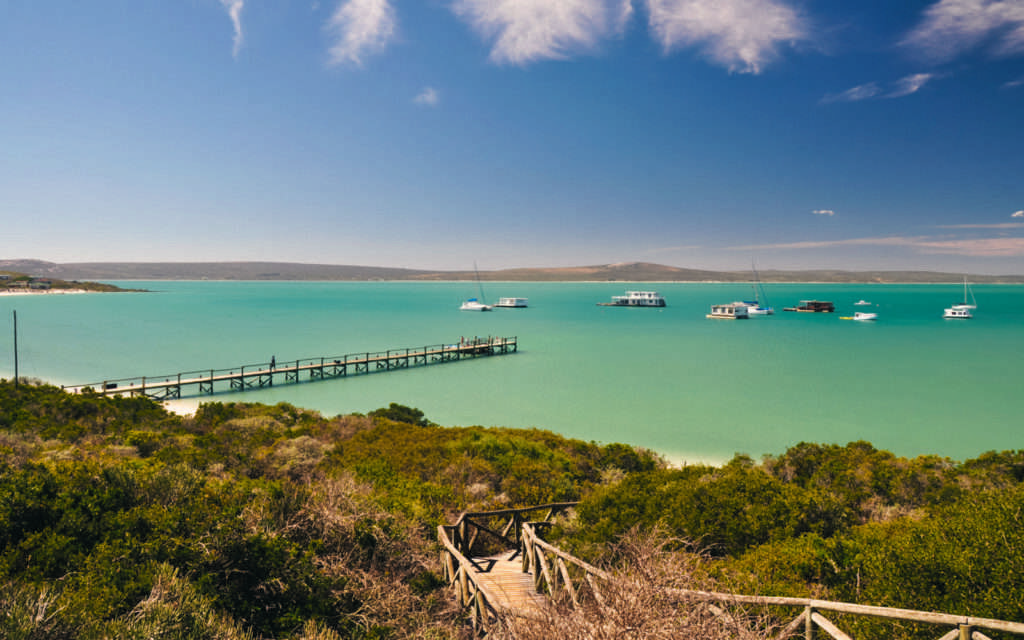
History of Langebaan
Province: Western Cape
West Coast
Coordinates:33°5′30″S 18°2′0″E
Area:20.17 km2
Municipality:Saldanha Bay
Evidence shows Homo sapiens lived here 500,000 years ago, hunting small game and crafting tools. Vasco Da Gama first explored the area in 1497. In the 1600s, the Dutch East India Company used Saldanha Bay’s calm waters for ship repairs.
Langebaan, founded in 1870 on the farm Geitenmelksfontein (“Goat’s Milk Fountain”), has a rich history. The town was a prominent whaling station until the 1960s.. Donkergat’s whaling station is still visible today. A harpoon gun outside the Municipal Buildings is a reminder. Whaling ended due to global pressure and declining whale populations.
By 1729, the VOC had expanded farming, establishing Geelbekfontein near Langebaan. They also built a second fort near Konstabelkop to supply water to passing ships. At Kraalbaai, the VOC set up “Oude Post” to manage resources and monitor trade. Dutch expeditions marked five islands in Langebaan Lagoon with monograms; the only surviving one is at Geelbek.
Saldanha Bay was named after António de Saldanha, although he never actually entered these waters. In 1601, Juris van Spilbergen mistakenly believed he had reached Cape Town and named it Saldanha Bay. The bay was originally called Agoada de Saldanha, but the Dutch later claimed ownership. Despite European interest, settlement was limited due to the lack of fresh water, as Langebaan Lagoon is a saltwater body.
Schaapen Island served as a quarantine station and storage site for seal skins and whale oil. French seal hunters used it, and it was called Isle la Biche before Dutch settlers renamed it. The other islands in the lagoon also supported the sealing and guano industries. Over 286 shipwrecks occurred along this coast.
The area witnessed two naval battles in 1863 involving the Confederate warship, Alabama.
William Smith, a British sailor, was the town’s first settler, building a cottage by the lagoon — his descendants still live here. Langebaan’s Dutch Reformed Church houses South Africa’s oldest pulpit.
Today, Langebaan is a residential town with no industrial activity permitted. The establishment of the West Coast National Park in 1985 helped preserve the natural beauty and ecology of the lagoon and surrounding areas. The lagoon is now a protected marine wetland and part of the RAMSAR convention for wetlands of international importance.
WEATHER IN LANGEBAAN TODAY
see all listings in Langebaan
Things to see and do in Langebaan:
- To explore the area on classic motorcycles, please visit African Dream Motorcycle Adventures
- The Postberg trail is only open once a year, between August and September for wildflower season. 022 772 2144/5
- Water sports, especially kite surfing and sailing,
- The local beach attracts kiteboarding enthusiasts from all over the world. Main Beach is one of South Africa’s favourite kiteboarding spots,
- Langebaan Lagoon is a protected natural wetland and a Ramsar site. It is an ideal birdwatching You may see flamingos, oystercatchers, gulls, and other rare water birds.
Useful Numbers
- Police: 022 707 5140/ 022 703 6440
- Municipality Moreesburg 022 433 8400
- Traffic department:0227036100
- Vehicle registration 022 707 5015
- Fire: 0227017061
- Water:
- Electricity:
- Ambulance:10177 private
- Post office: 022 772 2710
- Library: 022 707 5030
- Closest hospital;
Life West Coast private hospital, Vredenberg 022 719 1030
Seabreeze medical centre 022 772 1606 - Pharmacy;022 772 2470
- SPCA:West coast SPCA 022 289 0998 Langebaan animal care
- Schools: Longacres Private School 022 772 0302
Curro independentschool 022 772 0116 - Sea rescue 082 9905966
- Museum;
- Tourism; 022 772 1515
- Ratepayers Association:082 889 0685


